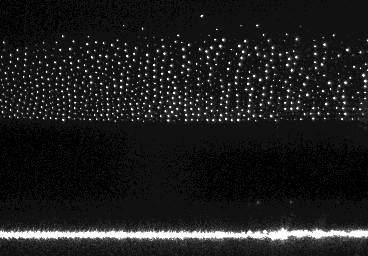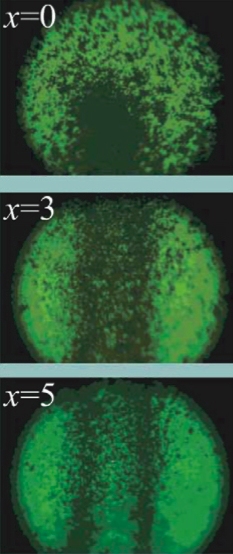
a plasmacrystal
from New Scientist:
“According to a new simulation, electrically charged dust can organise itself into DNA-like double helixes that behave in many ways like living organisms, reproducing and passing on information to one another.”
“Like DNA, the dust spirals can store information. They do so in the scaffolding of their bodies, as they have two stable states – one with a large diameter and the other with a small one – so a spiral could carry a series of wide and narrow sections.
The specific order of these sections can be copied from one dust spiral to another, like a genetic code. The researchers aren’t sure how it happens, but they think each narrow section of spiral creates a permanent vortex of moving dust outside it. So if another spiral drifts alongside it, that vortex pinches the same length into its narrow state.”
from Press Esc:
“They can divide, or bifurcate, to form two copies of the original structure and can also interact to induce changes in their neighbours and can even evolve into yet more structures as less stable ones break down, leaving behind only the fittest structures in the plasma.”

traces of a helical structure in a plasmacrystal
and the abstract of the article by V.N.Tsytovich, G.E.Morfill, V.E.Fortov, N.G.Gusein-Zade, B.A.Klumov and S.V.Vladimirov runs as follows:
“Complex plasmas may naturally self-organize themselves into stable interacting helical structures that exhibit features normally attributed to organic living matter. The self-organization is based on non-trivial physical mechanisms of plasma interactions involving over-screening of plasma polarization. As a result, each helical string composed of solid microparticles is topologically and dynamically controlled by plasma fluxes leading to particle charging and over-screening, the latter providing attraction even among helical strings of the same charge sign. These interacting complex structures exhibit thermodynamic and evolutionary features thought to be peculiar only to living matter such as bifurcations that serve as ‘memory marks’, self-duplication, metabolic rates in a thermodynamically open system, and non-Hamiltonian dynamics. We examine the salient features of this new complex ‘state of soft matter’ in light of the autonomy, evolution, progenity and autopoiesis principles used to define life. It is concluded that complex self-organized plasma structures exhibit all the necessary properties to qualify them as candidates for inorganic living matter that may exist in space provided certain conditions allow them to evolve naturally.”
The article itself question can be found at the New Journal of Physics.
